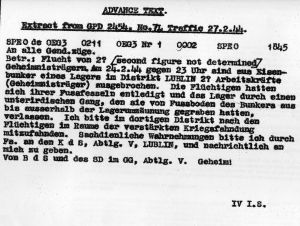Borek Forest

Borek Forest Escape - Decode 1944
The Germans established prisoner of war camps for Russian soldiers on Lwowska Street, in Chelm and Italian soldiers were also imprisoned there after Italy abandoned the Nazi cause. The Germans murdered an estimated 30,000 Soviet Prisoners of War and Italian Prisoners of War and buried them in the Borek woods. Josef Reznik, a Jewish soldier in the Polish army, had been incarcerated in Majdanek, and then was taken to the Lipowa Street camp in Lublin, was taken back to Majdanek in November 1943 to be murdered as part of the Aktion Erntefest. He was selected along with 300 other men by SS-
There they took us to pits, to some sort of trenches. I was digging with my spade. I hit the earth once or twice, and all at once the spade slipped and I realised that the spade had struck a human head, and such an evil smell came out of the earth. Then Rolfinger screamed at me and said, “Why did you stop? Don’t you know there are bodies lying there?
There in the first trench, which was 150 or 170 metres in length, there were about ten thousand corpses. They brought a mill for grinding the bones. Our people sifted the bones, so that the gold could be extracted, if there were any in the teeth. Rolfinger and his deputy Raschendorf, SS men from Chelm, took all the gold. The bones were brought to the grinding machine, and the ground bones were later brought to the fields and scattered there. There was such a stench that one could not keep one’s mouth open. We worked for three months, there were eight or nine graves, I cannot tell exactly, and one trench they kept open for more people. All that time, they were bringing in new people in trucks. The persons that were brought, the dead bodies – I do not know whether it was from gas or from the air-
The Germans used gas vans in the Chelm area, stationed at the Gestapo office in Chelm, possibly these vans were also kept at Lublin (Majdanek) near the SS garage. Reznik described what he saw when he opened one grave:
We were digging in one of the trenches and took out a certain number of corpses. The number was reported to Rolfinger who supervised the work. He looked at his notes and said, “Here five or eight more Jews are still missing. You must dig and find them.”
So I put in the spade again, and suddenly a wall collapsed, and there was another seven or eight corpses, and next to one of them was a ritual slaughterer’s knife, and he still wore the Star of David. Rolfinger knew exactly how many corpses were in each trench. After removing the bodies, chloride was spread in the pits. We filled the pits and we put soil on top. Over these pits, after filling them up, we also sowed grass. The corpses were burned, one thousand at a time. There were two such stacks for burning, such a mound of corpses burned for two or three days.
Reznik described his escape -
“We were put in fetters in our hut. In all four corners were machine guns. For every sixty or sixty-
This took us over two months of work, and the tunnel led to a new trench which was to receive fresh corpses. Our chains were inspected every day, one day immediately after the inspection we decided to break our chains. I do not want to brag, I broke the chains of eight men, with a kind of tool that could twist the chain, and it broke. Many ran away with the shackles on their legs. I managed to remove the shackles and fled through the trench. I remained alone. Four people saved themselves.”
Today at the site of the mass murder and cremation site there is a large memorial for the Soviet Prisoners of War and a smaller one for the Italian Prisoners of War murdered there.
SOURCES:
Eichmann Trial Transcripts – Nizkor
Sir Martin Gilbert, Holocaust Journey, Weidenfeld & Nicolson London 1997
National Archives – Kew – HW 16/69
© Holocaust Historical Society 2014

